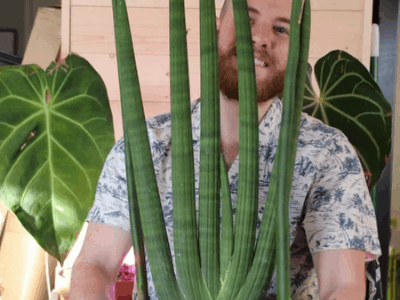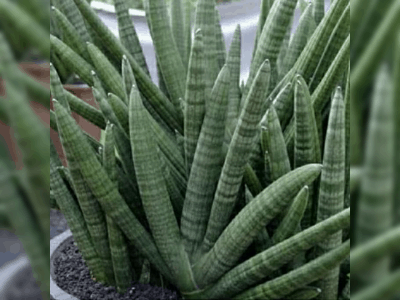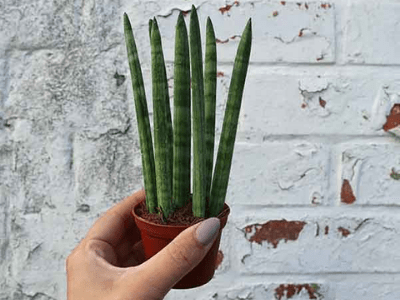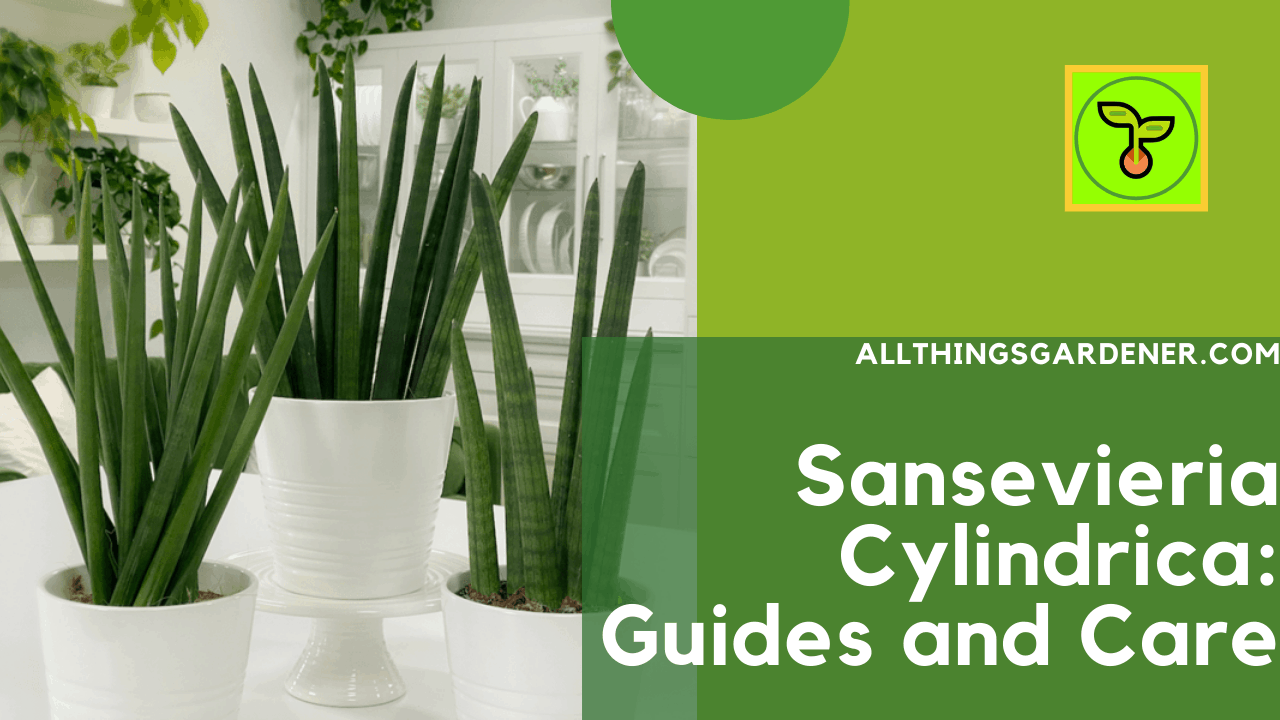
Sansevieria Cylindrica Care: Growing African Spear
I’m shocked that more people don’t grow Sansevieria cylindrica. The African spear plant is an incredible houseplant!
Its smooth, cylindrical leaves make it a real attention-grabber. The snake plant is a similar low-maintenance plant…
…but its similarity to the lucky bamboo is its versatility.
Like lucky bamboo, this plant can be braided in a fashionable pattern for a certain appearance.
Its leaves layer like the bowstring hemp plant, so let’s talk about the growing tips you’ll need to bring…
…this focal-point plant into your garden. You’ll love the elephant’s toothpick, as it’s commonly called.
I know I do have the same feeling like you! Before that, here we have story from Alex about his experience…
…having Sansevieria cylindrica for the first time as is houseplant.
Let us hear Alex’s story
I was not expecting to receive a Sansevieria Cylindrica when I signed up for my flat share.
The plants are so popular and hardy that they do not need much care or attention, which is perfect…
….for someone like me who does not have time to water them every day. I love the look of it in my living room…
…just by the window sill where it can get natural light during daylight hours.
It looks very calming too and has a nice green hue that makes it stand out amidst all my white furnishings.

The African spear plant (Sansevieria cylindrica), also known as the cylindrical snake plant, is a succulent that consists of upright, gray-green, subtly striped leaves.
Jon VanZile, author from thespruce.com
Here’s the main thing…
Quick Care Guide
Snake plants look quite different from each other when it comes to Sansevieria cylindrica.
- Common Name(s): Cylindrical snake plant, African spear or spear sansevieria
- Scientific Name Sansevieria cylindrica
- Family: Asparagaceae
- Light Bright light to full sun
- Soil Well-draining cactus mix
- Water: Water deeply, then allow to fully dry before watering again
- Pests & Diseases: Vine weevils, mealy bugs

All About African Spear
The African spear is a succulent evergreen native to Angola. They usually grow in dense stands…
….spreading by creeping rhizomes that grow under the ground. Easy to grow and to handle neglect…
…these plants are great for beginners. Sansevieria cylindrica is known for its cylindrical leaves…
….hence its common name cylindrical snake plant. It has tubular, smooth leaves, many of which…
…are deep green in color while others are olive green and have greenish-grey variegation.

There is a gorgeous variety as well called Sansevieria boncel, also known as spear orchid and skyline spear…
…with fat, short, cylindric leaves. Keep an eye out for this one! This plant flowers!
Cream-white flower spikes may appear on mature plants.
Lightly fragrant, they aren’t showy but are enjoyable nonetheless. Common names for Sansevieria cylindrica include:
- African spear
- Cylindrical snake plant
- Spear sansevieria
- Elephant’s toothpick
Go on…
Sansevieria Cylindrica Care
The Sansevieria cylindrica is usually quite a hardy plant that can survive even the harshest conditions…
…but if you want a healthy and elegant-looking plant growing in your house, then you need to ensure the following.

Light & Temperature
It can grow well in very low light conditions, but will grow better in bright sunlight. In the dark…
….bare plants won’t grow as much. Placing it near a north-facing window or sheer curtained window is a good idea.
During the day, outdoor plants do better with a bright light and shade during the harshest part of the day.
This arrangement helps the plant survive hot periods and extends its growing season. Cold temperatures…
….will cause damage to the plant, which naturally grows in hot and dry climates.
Anything below 50 °F (10 °C) can be too much for the plant to handle and result in cold damage.
It prefers room temperature and can adapt to mild fluctuations.
Water & Humidity
As a drought tolerant plant, it does not require frequent watering. Once every week is enough…
…during the summer growing season. Make sure the soil is free draining and dries out before you water again…
…as wet soil can cause root rot. Overwatering your plant results in the leaves turning yellow…
…or becoming mushy and soft at their base. You need to water once a month during winter or whenever the soil…
…becomes completely dry. Humidity is not a big concern for these plants, but that does not mean..
…they need extra humidity. They prefer a well-aerated environment not too drafty.
Next up…
Soil
A cactus potting medium is the best potting medium for the plants because it is fast draining.
It cannot tolerate a soggy potting medium and can quickly prove fatal. Be sure it grows well in well-drained…
…sandy soil nourished with organic compost that does not retain water.
Fertilizer
Once a month you can feed the plant with a fertilizer specifically formulated for succulents, mixed half…
…as strong as the recommended strength, spring into autumn.
The Sansevieria cylindrica has a light nutritional requirement. You should avoid feeding during the winters…
…when the plant’s growth is slow. As well as an organic granular fertilizer, you can also make the soil better…
…by adding some organic material.
Repotting
Sansevieria cylindrica are slow growers, especially if placed in low light conditions.
They will not require repotting for several years. However, if your plant has gotten crowded or outgrown the pot…
…you need to repot it. If possible, plants can be repotted in spring.
Transfer plants to new pots of progressively greater size. Wider containers are best since this plant expands top-heavy.
Be sure to give the plant some time to settle in the new pot before you start watering regularly.
Water sparingly until the plant has adjusted to the new container.
Go on…
Propagation
The African spear plant in its natural state. In order to propagate Sansevieria cylindrica plants…
…you must know they grow with rhizomes. If you want to propagate the plant, you can cut off the runners…
…or the offshoots and separate them with a sharp knife or blade before the stalks of the plant…
…are at least 6 inches tall and pot them individually.
Take a sharp knife and remove a cluster of leaves from the plant’s roots.
Then scratch off the old soil and plant the cutting in a new pot. Make sure the cuttings are at least 2 to 4 inches tall.
Additionally, they should be planted upright to ensure proper growth.
Pruning
If you want to prune Sansevieria plants for cosmetic purposes, there is generally no need to do so.
In fact, if you notice that a leaf is turning yellow, you can cut it at the roots with pruning shears.
Sansevieria cylindrica is popular for ornamental indoor plants because they are easy to care for.
Because of these reasons, they are generally preferred by busy gardeners because they are not troublesome.
Here are a few things you should consider about them.
Growing Problems
Though the African spear plant is tough and can thrive on neglect, one exception to this rule is that its containers…
…should be well-draining. Any growth problem is usually caused by overwatering.
Growing problems can result in lethal growth problems when too much water, cold temperatures…
…and inadequate light are present. Rotting roots with yellow leaves are normally caused by too much water…
..in this case, cut away the healthy part of the plant and repot it.
Pests
A Sansevieria cylindrica may get attacked by vine weevils, which can turn the edges of the leaves to powder…
…and cause irreversible damage to the plant. In the event that you see an adult weevil, you should immediately bathe…
…the potting mix with neem oil or another suitable product to destroy it.
However, if the roots have been significantly damaged it is unlikely that the plant will survive.
Last but not least…
Diseases
Sansevieria plants are not likely to be affected by diseases. The plants commonly get fungal infections…
…as a result of root rot. These infections can be treated with fungicides and with free-draining soil that is not kept wet.
Don’t worry about this. This plant is very strong at any condition. Can survive in extreme condition…
….and have good resilience about dieases, the only thing that can make this plant caught on diseases.
That is the wrong treatment for this plant.
Sum Up
See having Snake plant is good choice for you to have! It’s cool, its famous, it’s easy to have and care!
What else do you need? In this pandemic time like this, is a good choice for you to have an new activity…
…and having snake plant is a good choice for you to have!
Conclusion
Last thing for sure. This plant need to be care carefully, remember plant need the “love” too.
Alright that’s all for today! Do you have any questions about all of this?
Or do you want to add some good method for caring and having baby snake plant?
Let me know your recommendation from the comment below.
I hope you can now take care your snake carefully and grow it big!
Thanks for reading this article! Bye!

